| Vintage Pulp | May 19 2022 |

So just out of curiosity, why aren't you paddling an Uber? Seems like everyone else is.
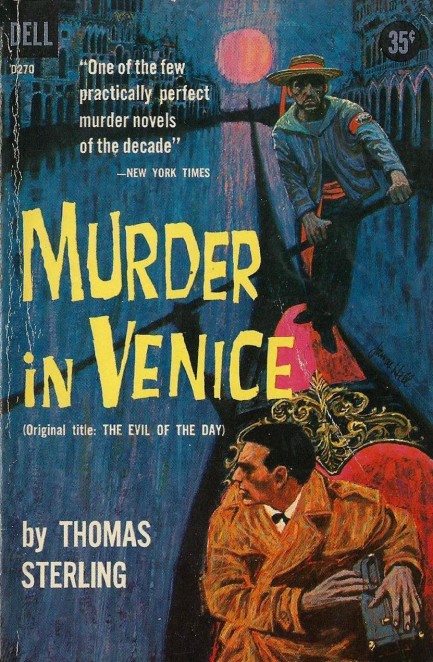
This spectacular cover for Thomas Sterling's Murder in Venice was painted by James Hill, an artist of obvious skill but one we rarely encounter. The book was originally published in 1955 as The Evil of the Day, with this beautiful Dell edition coming in 1959. Sterling tells the tale of a man named Cecil Fox who invites three guests from abroad to his Venetian mansion in order to pretend he's near death and tease them with the promise of inheriting his wealth. These three guests are people he's not had much contact with in recent years, which makes the game even more delicious for him, the way the trio feel plucked from their lives of obscurity to possibly be gifted wealth and status. Factions form and subterfuges abound, but everything is thrown into disarray when one of the guests is murdered. Was it to eliminate a possible inheritor? To add intrigue to the game? Or for other, unguessable reasons?
Go with option three. The whole point of murder mysteries is to be unguessable. Murder in Venice is a pretty good puzzler, with a small set of curious characters and a few forays into the Venetian night. Sterling gets inside the head of his protagonist Celia Johns quite effectively. She's the personal assistant to one of the invitees, and thus has no skin in the game. She just wants a fair wage for a fair day's work. At least that what she says. Her host Mr. Fox, on the other hand, seems to think everyone is corruptible, and everyone is money hungry—it's just a matter of baiting the hook in the right way. He thinks he knows most people better than they know themselves, and he doesn't see Celia as any sort of exception.
While Murder in Venice is a mystery, it's also a minor sociological examination of what it means to some people to be rich but face losing their money, and what it means to others to not value money at all. Sterling scored a success, but interestingly, he borrowed the idea from Ben Johnson's play Volpone, which premiered way back in 1606. Sterling was up front about his inspiration, and within his novel the play even makes an appearance on a drawing room shelf. Frederick Knott, who wrote the famed plays Wait Until Dark and Dial M for Murder, later adapted Sterling's novel into a 1959 play called Mr. Fox of Venice. The next year the book was published in France as Le Tricheur de Venise and won Sterling the Grand Prix de Littérature Policière for foreign authors. And finally, Joseph Mankiewicz combined the original play, Sterling's novel, and Knott's play into a 1967 movie called The Honey Pot.
When material gets recycled to that extent, it's usually good, and Sterling does his part. He was a diplomat before becoming an author and lived in Italy for years, so we would have liked more color from someone who obviously knew Venice well, but he's an interesting writer even without the aid of scenery, as in this moment of musing from Celia: She said, “my sleep,” as though it were, “my dress,” or, “my ring.” It belonged to her. Every night had a certain amount, and if she lost it she was frantic. She had forgotten that sleep was not a thing, it was a country. You couldn't get it, you had to go there. And it was never lost. Sometimes you missed a train, but there was always another coming after. In the meantime, neither the green hills nor the nightmare forests ever changed. They stayed where they were and you went to them. And sooner or later you would go and not come back.
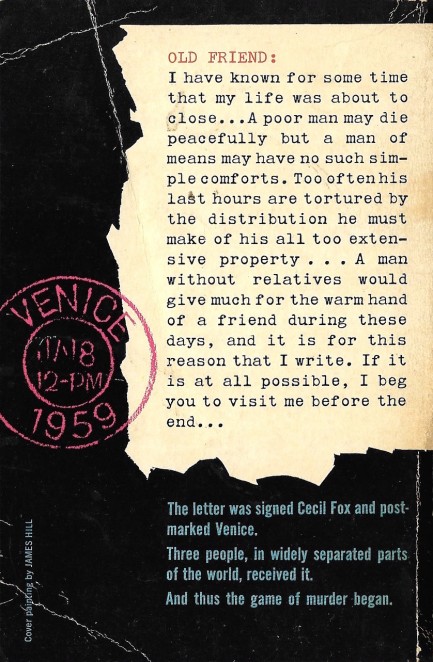
| Vintage Pulp | Nov 19 2021 |

How do you spell murder in Italian? H-i-t-c-h-c-o-c-k.
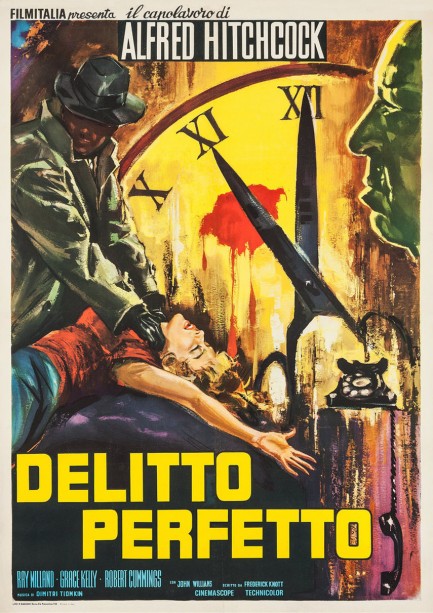
Above is a beautiful Italian poster for Delitto perfetto, better known as Alfred Hitchcock's Dial M for Murder, a movie we watch every five or seven years and always greatly enjoy. This semi-abstract effort isn't the only Italian poster for the film, but it's the best, in our view. We weren't able to find out who painted it, and considering it sold on a swanky auction site without that info, it seems as if nobody knows. Such good work uncredited, it's a shame. However, at this link you see another poster for the film, and that one is signed by Angelo Cesselon. Since both have a Hitchcock profile, and there's a stylistic similarity in other areas too, especially if you focus on the women's faces and the males' trench coats, we think it's possible Cesselon painted both pieces. The evidence wouldn't hold up in court, but it's good enough for us. Nice work, Angelo. Delitto perfetto premiered in Italy today in 1954.
| Vintage Pulp | Nov 19 2018 |

Their issues have gone way past the point of counseling.
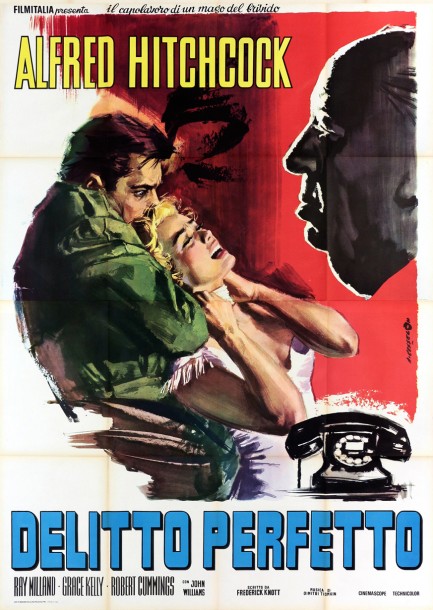
Dial M for Murder, which starred Grace Kelly and Ray Milland as spouses whose problems make other bad marriages look like a Sunday picnic, is a very entertaining movie. For its Italian release today in 1954 it was called Delitto perfetto. This violent but brilliant promo poster was painted by the genius illustrator Angelo Cesselon, who we've featured before. And Hitchcock, nothing less than an international phenomenon in his day, gets his profile into the mix. See Cesselon at his best here.
| Vintage Pulp | May 29 2018 |

Hello, is this the murder helpline? I'd like help killing my cheating ass wife.
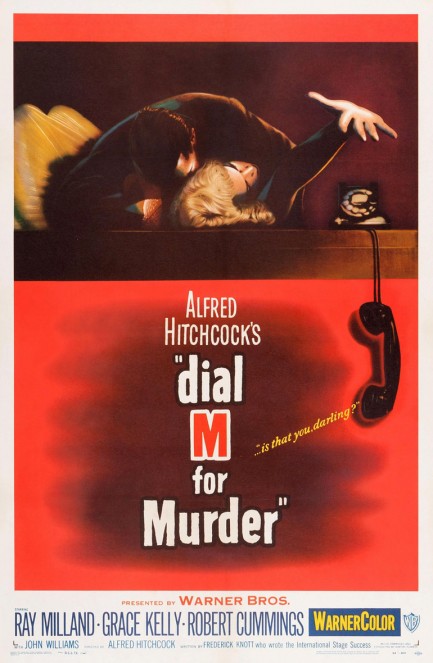
Most people who haven't seen the Alfred Hitchcock thriller Dial M for Murder jokingly ask, “How could anyone want to kill Grace Kelly?” Well, because she's cheating with another man. Not that infidelity justifies murder, but it certainly can be expected to provoke some sort of serious reaction. Probably Ray Milland, her husband, should have confronted her with the usual questions: “When did it start?” “Do you love him?” “Is his dick bigger than mine?” “Does he make you orgasm and if so how?”
But instead of being reasonable Milland decides his wife needs to be gone from the Earth, so he devises a foolproof murder plot. It goes wrong anyway and that's the fun of the movie—seeing how he cleverly improvises over and over only to have his scheme unravel anyway because of one tiny thing he neglects to consider. Dial M for Murder is another winner from Hitchcock, one you should see if you haven't. It went into general release in the U.S. today in 1954.
The famed poster for the movie was painted by Bill Gold, whose credits include everything from Casablanca to Unforgiven. Gold was active from 1941 to 2011, accumulating numerous awards along the way, and is now retired at age ninety-seven. If you want to learn more about him there's a website that discusses and showcases his seven decades of movie work which you can access at this link. It's well worth a visit.
But instead of being reasonable Milland decides his wife needs to be gone from the Earth, so he devises a foolproof murder plot. It goes wrong anyway and that's the fun of the movie—seeing how he cleverly improvises over and over only to have his scheme unravel anyway because of one tiny thing he neglects to consider. Dial M for Murder is another winner from Hitchcock, one you should see if you haven't. It went into general release in the U.S. today in 1954.
The famed poster for the movie was painted by Bill Gold, whose credits include everything from Casablanca to Unforgiven. Gold was active from 1941 to 2011, accumulating numerous awards along the way, and is now retired at age ninety-seven. If you want to learn more about him there's a website that discusses and showcases his seven decades of movie work which you can access at this link. It's well worth a visit.
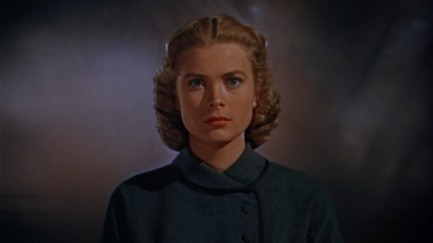 Could he really be trying to kill me?
Could he really be trying to kill me?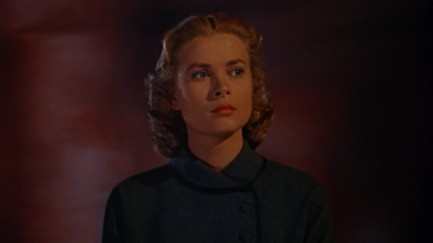 I guess it's possible, considering I cucked and humiliated him.
I guess it's possible, considering I cucked and humiliated him. 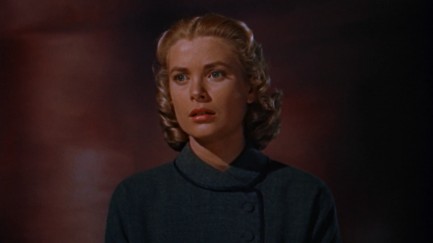 Maybe I shouldn't have told him I'm multi-orgasmic now.
Maybe I shouldn't have told him I'm multi-orgasmic now.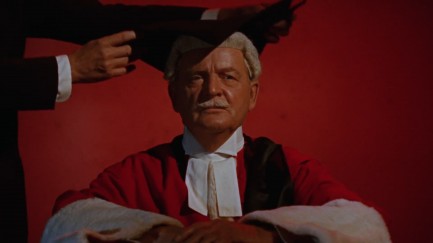 For the crime of murdering the male ego I sentence you to hang by the neck until dead, dead, dead.
For the crime of murdering the male ego I sentence you to hang by the neck until dead, dead, dead.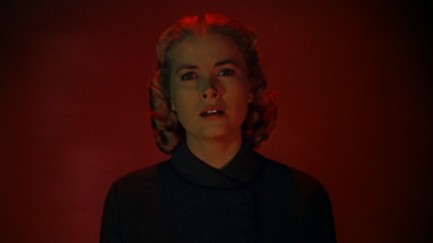 What? Seriously? But I've only gotten a third of the way through 101 Sex Positions.
What? Seriously? But I've only gotten a third of the way through 101 Sex Positions. 



































































